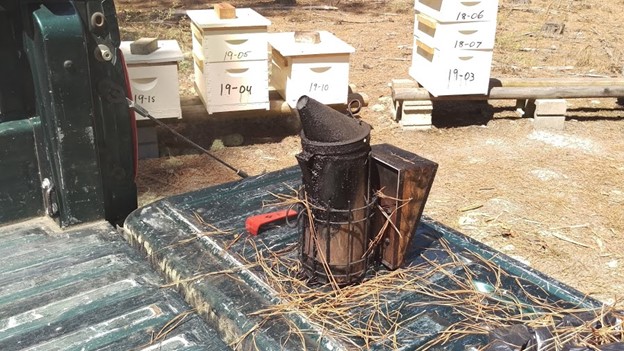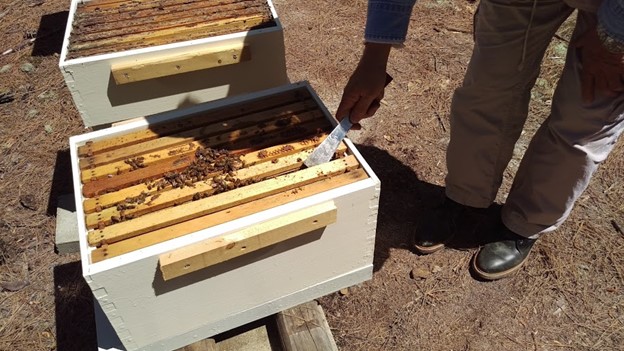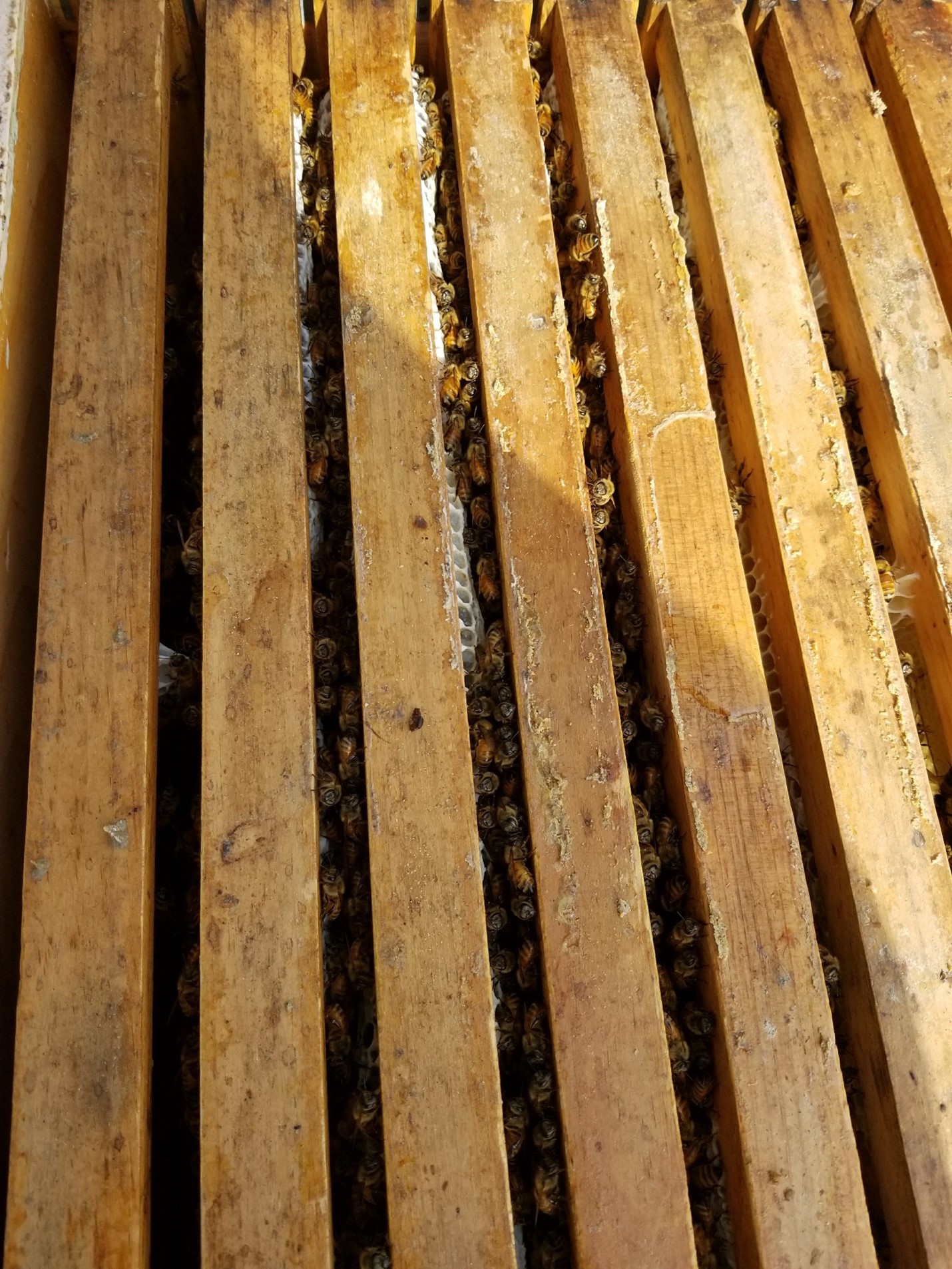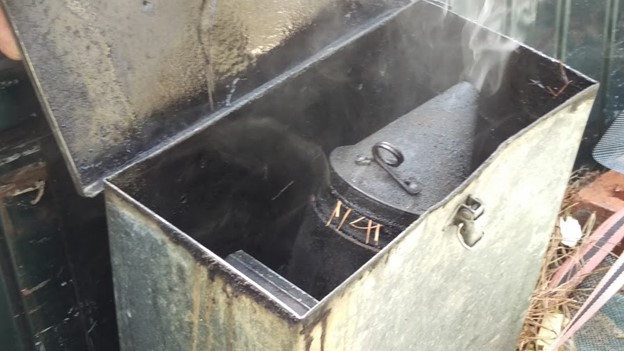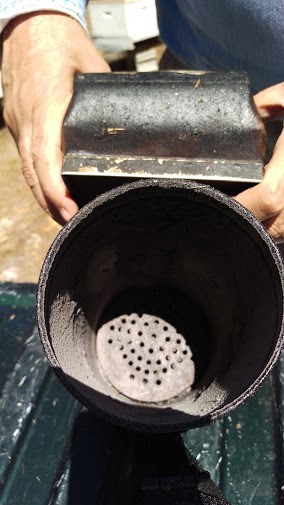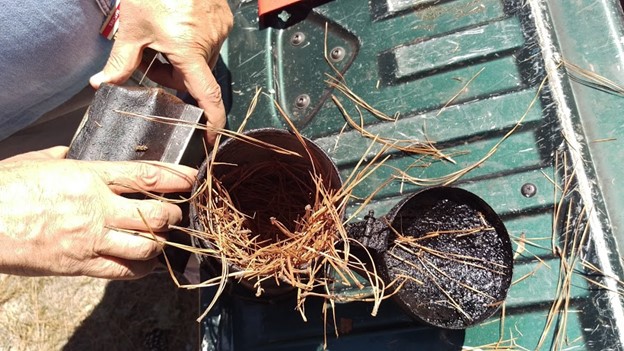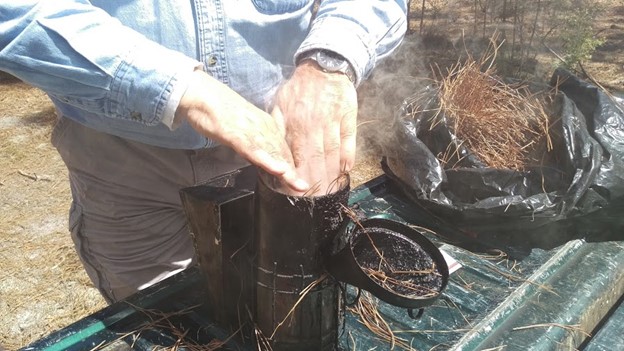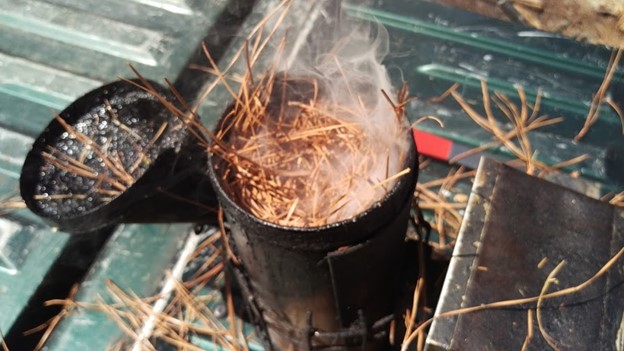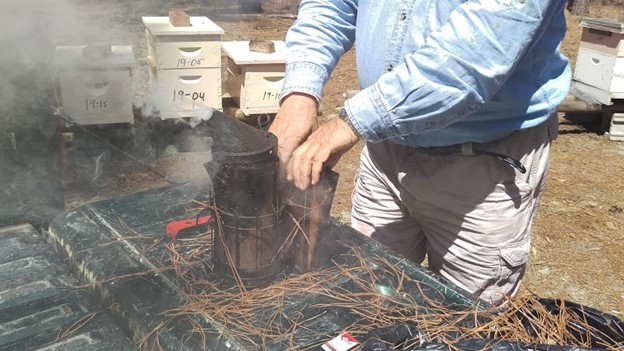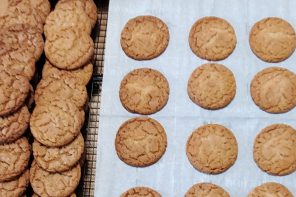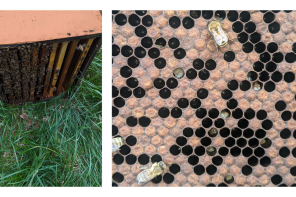David MacFawn
What size smoker and fuel you use can have a large impact on the beekeeper’s satisfaction. Large smokers are generally easier to light and stay lit for a longer time. Smokers with a finger guard are more comfortable to use. What type of fuel you use also impacts the smoker’s ability to stay lit. Proper use of smoke will help the beekeeper control and manage their bees.
There are two schools of thought as to why smoke works. One school of thought is it interferes with the bees’ senses and masks alarm pheromones released by guard bees. The other school of thought is it makes the bees believe there is a fire and their colony is in danger. This results in the bees gorging themselves filling their honey stomachs. This makes it more difficult for the bees to sting.
Smoking the frame ends moves the bees so you can pick up the frame with your hands. When smoking, you only need a puff or two from a well-lit smoker to control the bees. If you smoke too much, the bees often get upset. After working a few colonies, you should start getting a sense of how much to smoke by listening to and watching the bees. Here is where you need to learn what a normal colony does.
After a while you will find using gloves is cumbersome. However, there are times when you may want to use gloves. Wearing gloves may make sense during cooler weather when the bees are very defensive, such as the Autumn, Winter, and early Spring when the temperature is in the 50s°F or cooler. You want to work colonies when it is 60°F or warmer, a temperature greater than they visibly cluster (57°F). Other times you may want to use gloves are when rushing through hives, during wet weather, early morning, late evening or anytime when forager bees are in high numbers within the hive. You may want to try using gloves with the fingers cut out initially to get used to not wearing gloves. Two layers of nitrile gloves also work well.
Move slowly when working colonies so the bees do not become defensive. Don’t wear strong perfumes or scented deodorant. When you do get stung scrape across the stinger from the top to minimize injecting more venom into the skin; do not squeeze and pull the stinger from the skin. Then smoke the area to mask the alarm pheromone. During the nectar flow, bees are easy to work. During the dearth or Winter, the bees are more defensive.
When smoking the bees, smoke the entrance, under the inner cover or migratory cover, puff smoke lightly over frames and smoke the ends of frames so you can pick up/remove frames without squashing bees. Listen to the bees to determine when to smoke. Smoke lightly when bees are looking up at you from between the frames. Smoke the bees if they get loud or noisy. Smoking the entrance supports the theory that when bees detect smoke, they engorge themselves with honey in anticipation of possibly having to leave the hive. When engorged, it is more difficult for them to bend their abdomens to sting. Smoking at the entrance also supports the theory that smoke interferes with the bees’ sense of smell. One word of caution, be careful not to “bang” your smoker against the hive. It should be noted that over-smoking can irritate the bees. Just one to two puffs from a well-lit smoker is all that is needed. If the bees are emitting a loud noise/hum, they may be telling you that you have been in the hive too long.
When using a standard hive tool, pry under the top bar where the frame is the strongest and thickest to loosen and remove a frame. Do not pry under the frame end which may break the end frame ear in some cases (avoid prying between the end of the frame and the inner hive frame rest rabbit). If you damage some of the comb prying, the bees will easily fix it. Certainly, if using the J-hook hive tool, you can get under the frame end, but sometimes you may break off the frame end. It takes careful work to loosen the outermost frames (frames 1 and 10 in a ten-frame hive). You should scrape the propolis off the top ends of the top bars and pry on the sides of the end bars between the side of the hive and the frame.
When working the colony, go around the Langstroth hive and not over the frames with your hands/arms. Bees get excited when you move hands over the frames- especially when moving quickly. An experienced beekeeper holds their hive tool in their hand as they sequentially remove and inspect frames.
Remove the second to outside inner frame (typically #2 or #9 in a ten-frame hive) since the outside frame may be propolized to the inside of the woodenware. Move slowly without quick motions. Remove frames one at a time. Check the first frame removed for the queen. If the queen is not seen set the frame aside. Sequentially remove the remaining frames, looking at each frame and placing the frame looked at back into the hive. Keep all the frames, except the first one removed, in the hive. Keeping the frames in the hive will minimize the chance the queen gets lost on the ground. Additionally, it helps keep the frames in the correct order and orientation. When replacing frames, be careful you do not “roll” the queen and kill her. Move the frames in the hive apart with your hive tool to ensure there is plenty of room to insert or remove the frame without rolling bees or queen.
The frames should be inserted in the same order and orientation that they came out of the hive. Also, hive bodies and supers should be reassembled in the same order they came apart.
The size of your smoker should match the number of colonies you are going to work. A good quality Smoker 4 x 10 Stainless Steel with Shield will cost $55 to about $60. A 4-inch in diameter by 7-inch-tall smoker (4×7) is good for five to ten colonies in the same yard before inserting more fuel. A shield is nice to keep the beekeeper’s fingers from touching the hot smoker canister. A 4-inch in diameter by 10 inches tall smoker (4×10) is recommended for over ten colonies or colonies in several outyards. Again, a heat/finger shield is recommended. Smokers today are made out of stainless steel rather than tin which prolongs the smoker’s life.
A 4×10 smoker will last two to three hours if packed correctly. The fire should be started and coals established before packing the canister tightly with fuel. The smoker should be lit from the bottom. I use pine needles and pack the canister with as many pine needles as I can pack into the canister. I live in the Columbia, South Carolina area and I can pick up pine needles for free.
Collecting pine needles that have been run over by cars on a road makes lighting a smoker easier and more comfortable. The pine needles are soft and pliable and easy to stuff into a smoker’s canister. Also, pine needles that have been run over with a mower and collected in a bag, make the pine needles soft.
A metal smoker box is recommended to transport the smoker from one beeyard to another or to place the smoker after use. A metal smoker box may be purchased from a bee supply company, or it may be something as simple as an old correct-size Amo box. When finished using the smoker, the nozzle hole should be closed with a cork, rag or other material to put the fire in the smoker out. This will allow coals to be available for quickly lighting the smoker the next time.
If you do not close the smoker nozzle after placing your smoker in a metal box, if packed correctly it will still be smoking for use later. However, if the smoker is not going to be used anymore, the smoker nozzle hole should be stuffed closed with a cork, rag or other material. This will keep creosote from building up if using pine needles and save some coals for later use.
There are a variety of smoker fuels. You want to use something all-natural, without grease/oil, pesticides or preservatives. Pine needles, punk wood (rotten wood) from cherry, hickory, or other hardwood, wood shavings and burlap all work well. Some beekeepers even use dried grass/hay. Smoker fuels are often available from bee supply companies.
Creosote buildup will occur with pine needles and other wood products with rosin. Creosote buildup can be burned with a propane torch and removed with a hive tool or chisel.
“Frank Eischen who was with USDA’s Agricultural Research Service in Weslaco, Texas, has tested smoke from 40 different plants to control varroa mites. The most promising are dried grapefruit leaves and creosote bush, a woody perennial. Creosote bush smoke drove 90 to 100 percent of the mites off bees after a one-minute cage test. Grapefruit leaf smoke drove off 90 to 95 percent of the mites in 30 seconds. The findings are preliminary: more research is needed before scientists could recommend that beekeepers use these plant smokes to control mites.” It should be noted that Creosote and Grapefruit may be harsh on your bees like tobacco was found to be.
“After 30 seconds, smoke from the grapefruit leaves knocked down 90 to 95 percent of the mites in the cage test. With grapefruit leaves, however, few of the mites are killed. Most simply fall off the bees.”
When emptying a smoker of totally burned fuel, make sure you turn the smoker upside down and squeeze/puff on the bellows to remove debris under the metal grate in the bottom of the smoker. If you have some fuel that is not burned/consumed, the partly burned fuel can be placed back into the canister for easy lighting of the smoker.
In Figure 3, note I left a hole in the center of the pine needles to drop a match and light the pine needles from the canister bottom. This will allow an initial amount of coals to be lit.
The keys to getting a smoker lit and staying lit are:
Establishing a lot of coals in the canister bottom initially.
After the smoker is well lit, packing the canister tightly with fuel, pine needles. If the smoker is initially lit correctly, after packing tightly it will not go out until the fuel is consumed. The smoker will often stay lit for two to three hours.
After a well-lit smoker sits for a couple of minutes, two to three puffs on the bellows should get your smoker working again.
You want a cool, white smoke emitting from your smoker. A hot blast coming from your smoker will burn the bee’s wings, hair/setae and antenna.
A properly lit smoker makes working bees easier and more enjoyable. Lighting the smoker from the bottom, establishing a well-lit coal base, and stuffing the smoker’s canister tightly with fuel is the key to maintaining a well-lit smoker, emitting plenty of cool, white smoke. Only a puff or two is typically required to control the bees from a well-lit smoker. Proper smoke use will help control and manage your bees.
David Elgie MacFawn is a North Carolina Master Craftsman Beekeeper (October 16, 1997), Eastern Apicultural Society Master Beekeeper (2019), Co-Founded the South Carolina Master Beekeeping Program, awarded 1996 & 2020 South Carolina Beekeeper of the Year, and published over 60 articles in the American Bee Journal, Bee Culture, and Beekeeping: Your First Three Years. David is a 2021 CIPA EVVY™ Awards Book Second Place Competition Winner and has published four books and twenty YouTube videos.





